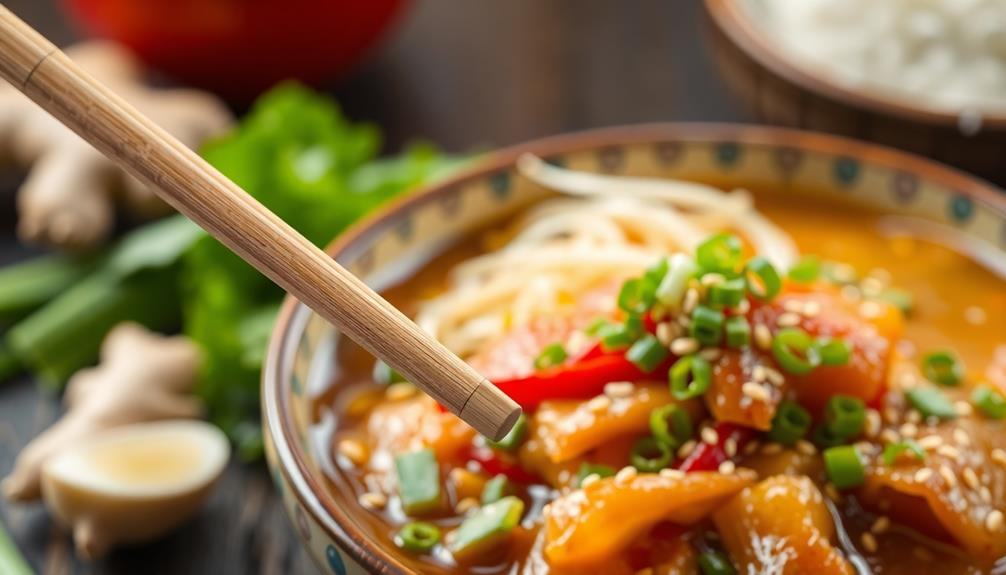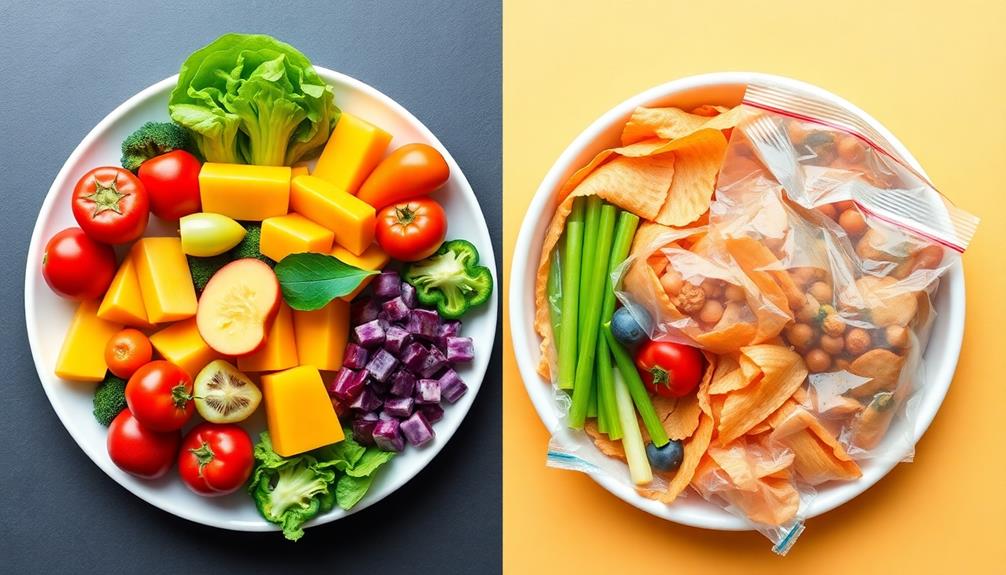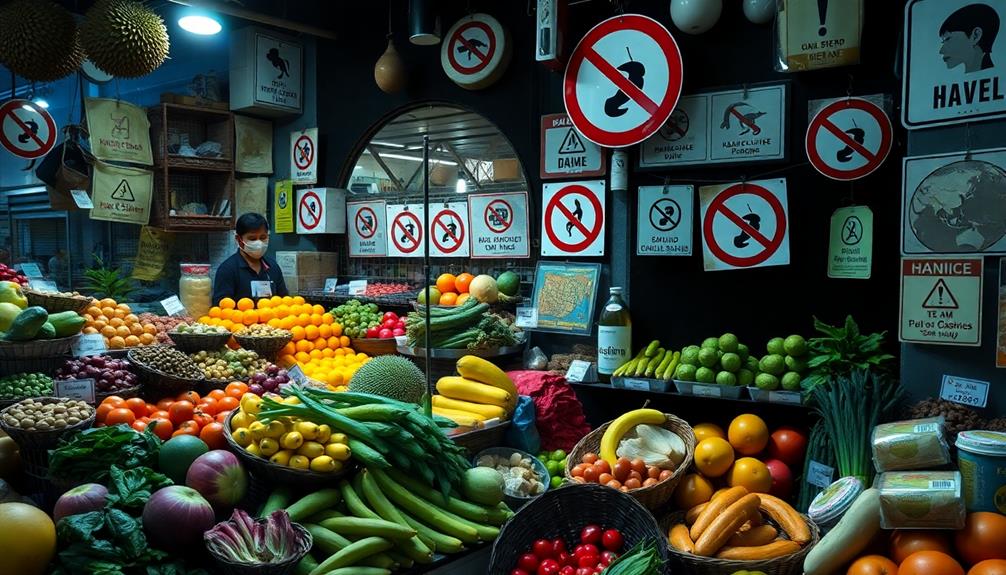Certain foods are tied to holidays because they connect us to our past and loved ones. Each dish tells a story that celebrates our culture, like turkey at Thanksgiving or tamales for Christmas. Sharing meals makes us feel closer, creating laughter and warmth together. These foods often remind us of happy times and family traditions, transforming ordinary ingredients into special memories. Plus, holiday meals boost the economy, benefiting local farms and eateries. So, when you enjoy these festive treats, you're not just eating—you're part of something bigger! If you're curious, there's so much more to explore about these tasty traditions!
Key Takeaways
- Holiday foods preserve cultural heritage, connecting generations through shared culinary practices and traditions.
- Unique dishes like turkey at Thanksgiving and tamales during Christmas symbolize community bonds and celebration.
- Aromas and flavors of holiday meals evoke cherished memories and foster emotional connections among family and friends.
- Economic impact during holidays includes increased spending on food, catering services, and temporary job creation in the food industry.
- Healthier recipe modifications and mindful eating practices promote well-being while enjoying traditional festive dishes.
Cultural Significance of Holiday Foods
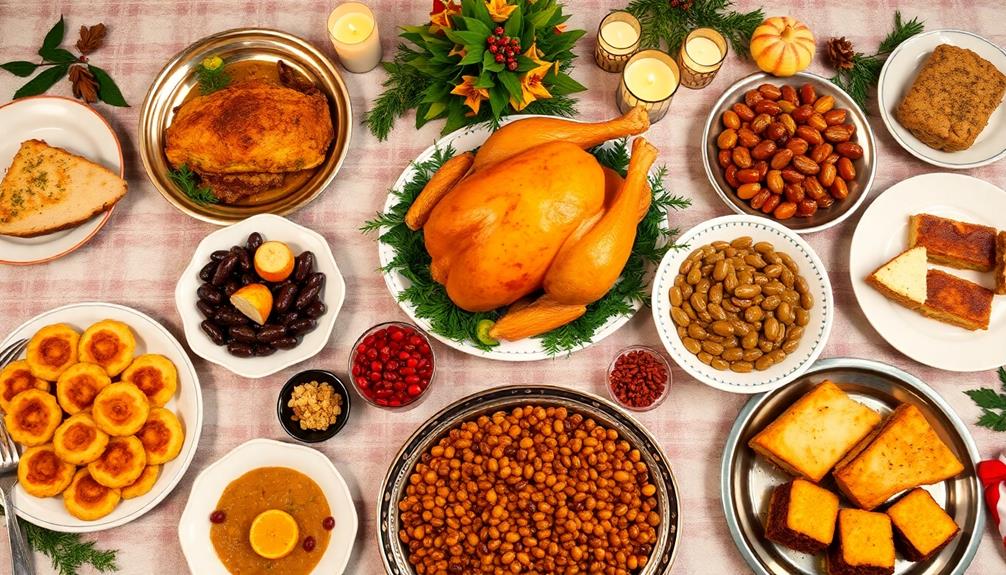
Holiday foods hold immense cultural significance, often acting as a bridge between generations and preserving unique culinary practices. When you think of traditional holiday foods, they often bring back warm memories of family gatherings, laughter, and shared stories.
For example, many families enjoy making a comforting turkey soup from leftover turkey, which not only reduces waste but also keeps cherished traditions alive. These dishes connect you with your heritage and create bonds within your community.
Here are some examples of traditional holiday foods that carry meaning:
- Latkes during Hanukkah symbolize the miracle of oil, reminding everyone of hope and resilience.
- Turkey and pumpkin pie at Thanksgiving showcase how immigrant traditions blend into American culture, showing that food can evolve while still honoring history.
- In Italy, panettone is a festive treat enjoyed during Christmas, while mincemeat pie in England adds a rich, historical touch to holiday celebrations.
These foods do more than just fill your plate; they foster connections across different backgrounds and beliefs. Sharing a meal can break down barriers, bringing people together in joy and celebration.
Historical Origins of Festive Dishes
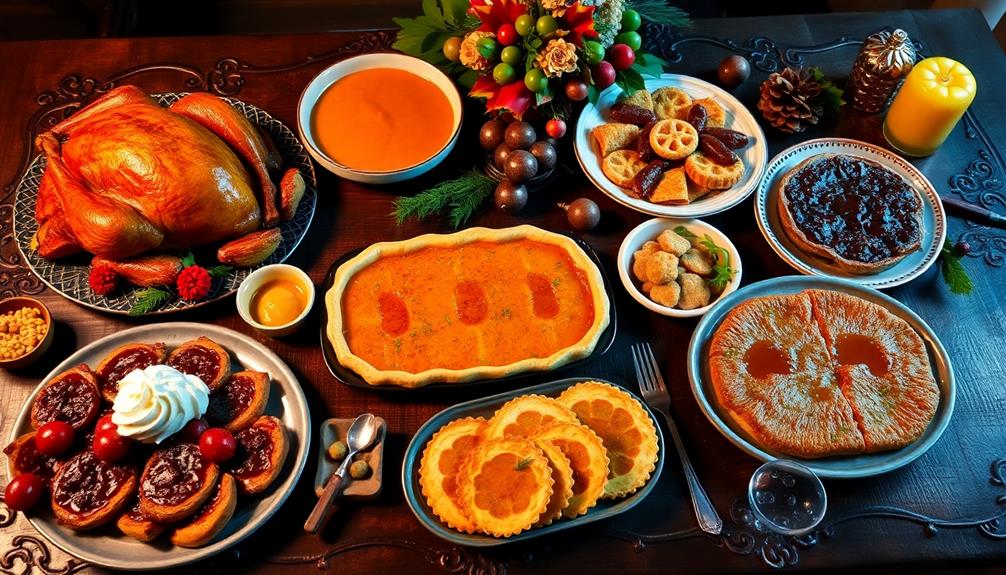
Festive dishes often carry a rich tapestry of history, reflecting the cultural practices and resourcefulness of their time. When you think of traditional holiday foods, it's fascinating to contemplate their origins.
For instance, many festive gatherings now feature graveyard taco dip or bloody Shirley temples that add a fun twist to celebrations. Here are some delightful examples:
- Fruitcake: This treat dates back to ancient Rome and evolved through the Middle Ages. It included dried fruits and spices, showcasing early preservation methods during festive celebrations.
- Christmas Puddings: Traditional puddings, like figgy pudding, were dense and loaded with dried fruits. They were often soaked in alcohol and lit on fire during Advent, making them a fun centerpiece!
- Mincemeat Pie: Originally, this pie contained meat and suet along with dried fruits. It was a clever way to use preserved ingredients in winter, highlighting the importance of resourcefulness in holiday cooking.
- Wassail: This warm punch, enjoyed during Christmas gatherings, has its roots in 19th-century traditions. It's perfect for sharing with family and friends, keeping everyone cozy!
These traditional foods not only taste great but also remind us of the rich histories that make our celebrations special. Each bite carries a story!
Bonds and Togetherness Through Food

Food has a unique power to bring people together, creating bonds that last long after the last bite. When you share a traditional holiday meal, you're not just eating; you're making memories! Each dish has a story, often tied to family history, much like how Mushroom Masala enhances gatherings with its rich flavors. This sharing fosters a feeling of belonging and togetherness among friends and family.
- Breaking bread together symbolizes unity, helping everyone feel welcome, no matter their differences.
- Cooking and preparing meals often involve collaboration, so you might find everyone pitching in to make Grandma's special recipe!
- Nostalgic flavors can spark conversations, reminding you of past gatherings and the bonds you've formed over the years.
Holiday meals elevate simple foods into special moments, reminding us of the importance of connection. You laugh, share stories, and support one another, creating lasting bonds that strengthen your community.
Emotional Connections to Culinary Traditions

During gatherings, the aromas and flavors of cherished dishes transport you back to simpler times, where laughter and love filled the air.
These emotional connections to culinary traditions are powerful, especially during the holiday season. Each dish tells a story, bringing together family and friends for joyful celebrations.
For example, traditional Brazilian dishes like Caldeirada evoke a sense of warmth and togetherness, as they're often shared during festive occasions.
Here are a few reasons why food holds such a special place in our hearts:
- Nostalgia: Certain flavors, like Grandma's famous raisin pie, remind you of childhood memories and warm family moments.
- Shared Experiences: Gathering around the table for special meals creates lasting bonds through the stories shared and laughter echoed.
- Symbol of Love: Holiday dishes often carry sentimental value, symbolizing care and togetherness that go beyond their taste.
- Cultural Heritage: Unique recipes can connect generations, passing down traditions that enhance your sense of community and belonging.
As you savor each bite, you're not just enjoying food; you're partaking in a rich tapestry of memories and connections.
These culinary traditions help make the holiday season a time of joy and celebration, where every meal becomes a cherished experience.
Evolution of Holiday Food Trends

Evolution of Holiday Food Trends
Tradition shapes how we celebrate holidays, and over the years, holiday food trends have transformed considerably. In ancient times, feasting was all about honoring deities and celebrating harvests.
Today, our holiday meals focus more on togetherness and cultural heritage. For example, many families may incorporate elements of traditional Mexican cuisine, such as Chilaquiles, into their holiday breakfasts, showcasing the rich flavors and history behind these dishes.
Here's how holiday food trends have evolved:
- Cultural Blends: Immigrant traditions have mixed with American customs, especially for holidays like Thanksgiving. Now, turkey and pumpkin pie reflect a delicious blend of cultures.
- Plant-Based Choices: More families are choosing vegetarian or vegan options. This shift promotes sustainable eating while still enjoying festive meals.
- Digital Sharing: With the rise of digital platforms, sharing recipes and meal ideas has become easier. Virtual gatherings and online cooking classes create new holiday traditions.
- Fusion Fun: As cultures mix, we see unique holiday dishes emerge, combining flavors from around the world while keeping local significance.
These exciting changes show how holiday food keeps adapting.
Symbolism Behind Traditional Dishes

As holiday meals evolve, the symbolism behind traditional dishes remains an essential part of the celebration. Each dish tells a story, connecting us to our roots and the joys of sharing. For instance, in Japanese culture, certain foods like Dorayaki (Red Bean Pancake) are often enjoyed during festivals and family gatherings, symbolizing togetherness and sweetness in life.
Here are some delightful examples:
- Roast turkey for Thanksgiving symbolizes abundance and gratitude, reminding us of the harvest's riches.
- Latkes for Hanukkah represent resilience; these crispy treats remind us of the miracle of oil that lasted eight days.
- Fruitcake, with its mix of dried fruits and spices, stands for prosperity. It hails from ancient times when preserving fruits was essential for winter festivities.
- Wassail, the warm spiced drink, embodies hospitality and community, perfect for sharing with loved ones during holiday gatherings.
These traditional dishes not only fill our plates but also warm our hearts. They remind us of the importance of togetherness, gratitude, and the stories passed down through generations.
Economic Impact of Holiday Meals
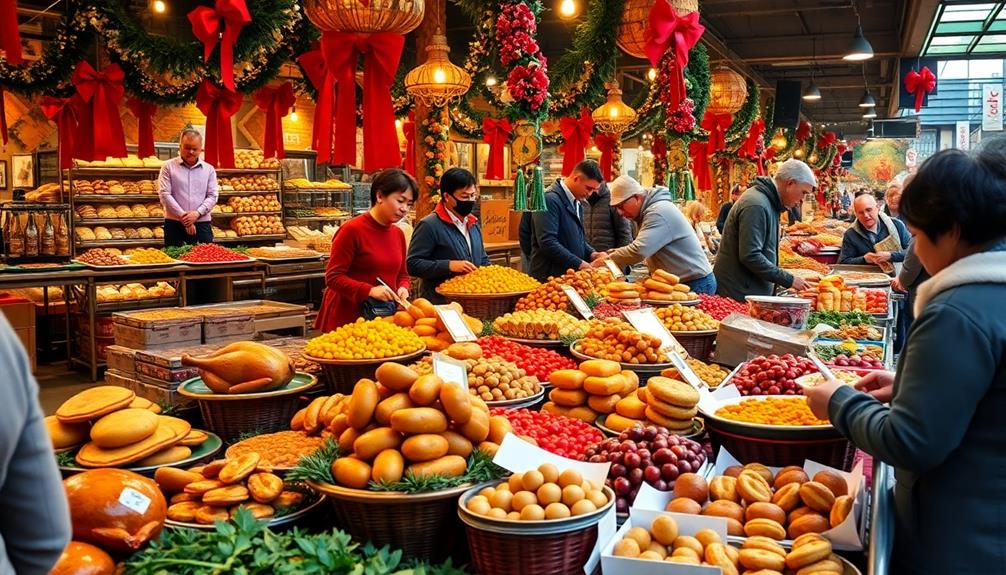
When the holidays roll around, you can really feel the excitement in the air, especially when it comes to food!
Holiday meals not only bring joy to your table but also create a big boost for the economy, with many people spending a lot on delicious dishes and catering services.
Seasonal dishes, such as Nettle and Potato Soup, often feature fresh, locally sourced ingredients that highlight the flavors of the season.
Plus, this special time of year opens up new job opportunities, helping everyone get ready for the festive feasts!
Holiday Food Sales Surge
The holiday season brings a remarkable surge in food sales, greatly impacting the economy. This time of year, families gather for special occasions, and you might be surprised to learn how much money is spent on food and drinks.
In the U.S. alone, consumers shell out around $200 billion annually during the holidays! Traditional Southern dishes, such as satisfying squash casserole, often make an appearance on holiday tables, further driving demand for ingredients.
Here's how this holiday food sales surge affects various sectors:
- Catering and Meal Delivery: Orders increase by 20-30%, making it easier for you to enjoy festive meals.
- Restaurants: Expect a 50% spike in reservations during Thanksgiving and Christmas, as everyone loves dining out!
- Local Farmers: Many restaurants and families prefer seasonal, locally sourced ingredients, helping local economies thrive.
- Food Industry Jobs: Seasonal hiring goes up by 10-15% to meet the heightened demand for food production and service.
Employment Opportunities Increase
During the holiday season, employment opportunities in the food industry surge considerably, creating a wealth of temporary jobs that cater to increased demand.
Many people seek out traditional dishes such as bulgogi (marinated beef) and kimchi to celebrate their festive gatherings. As you prepare for festive gatherings, you might notice more people working in restaurants and catering services.
This is because many folks want to enjoy traditional Christmas foods, and restaurants often see a 20% increase in customers.
Here's how this impacts the job market:
- Seasonal Hiring: Many businesses start hiring in November and December, leading to thousands of temporary jobs.
- Local Benefits: Farmers and local producers also get a boost as people seek fresh ingredients for their holiday meals.
- Economic Impact: With Americans spending over $200 billion on holiday meals, the food industry thrives, generating many jobs.
Catering and Delivery Demand
As families gather to celebrate the holidays, many turn to catering and delivery services for convenience, leading to a notable spike in demand. You might be surprised to learn that nearly 25% of consumers plan to order takeout or delivery for their special holiday meals!
This trend not only makes life easier but also boosts local economies. Here's how:
- Increased Revenue: Restaurants often see a 20-30% rise in revenue from catering for corporate parties and family gatherings. For instance, themed foods like Graveyard Taco Dip can enhance the festive atmosphere and encourage more orders.
- Support for Local Farmers: Many restaurants prioritize seasonal ingredients, benefiting local farmers and food producers.
- Job Growth: Employment opportunities in food-related industries rise by about 10%, creating more jobs during the festive season.
- Festive Treats: Don't forget the fun of gingerbread houses! Many families order these festive treats for decoration and enjoyment.
With everyone busy preparing for holiday festivities, it's no wonder that catering and delivery services play a crucial role.
Health Considerations During Celebrations
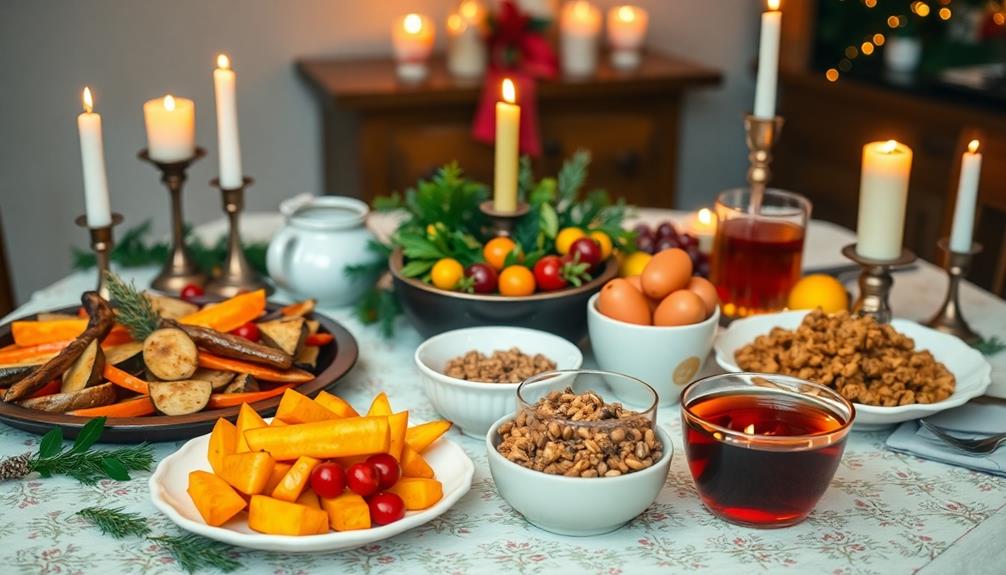
When the holidays roll around, it's easy to get carried away with all the tasty treats!
To keep everyone feeling great, you can focus on portion control and sneak in some fruits and veggies alongside those rich dishes.
Plus, trying out healthier recipe swaps can make your festive meals both delicious and nutritious, so everyone can enjoy the celebration!
Nutritional Awareness During Festivities
How can you enjoy festive meals without compromising your health? With a little nutritional awareness, you can make delicious choices that keep the joy of celebration alive! Here are some tips to help you navigate holiday feasts:
- Watch Your Portions: Serving sizes can be larger than usual during holidays. Try using smaller plates to help control how much you eat.
- Add Color: Incorporate fruits and vegetables into your meals. They not only add flavor but also bring essential nutrients to your plate.
- Mindful Eating: Take your time to savor each bite. Pay attention to your hunger cues, and stop when you feel satisfied, not stuffed!
- Educate Yourself: Learn more about nutrition during the holidays. Knowing what's in your food can help you make healthier choices for you and your family.
Healthier Recipe Modifications
Often, holiday meals can be indulgent, but that doesn't mean you can't make them healthier. You can enjoy all the festive flavors while making some simple healthier recipe modifications. Here are a few ideas to get you started:
| Traditional Ingredient | Healthier Alternative | Benefits |
|---|---|---|
| White flour | Whole wheat flour | More fiber and nutrients |
| Sour cream | Greek yogurt | Lower in fat and calories |
| Sugar | Honey or maple syrup | Natural sweetness, fewer calories |
| Rich desserts | Fruit-based options | Adds vitamins and fiber |
By switching to whole grains, you'll enhance the nutritional value of your favorite baked goods. Also, using Greek yogurt in place of sour cream can help cut down on fats. Don't forget to add more fruits and veggies; they'll balance out those rich dishes!
Reducing sugar in desserts can also help. Natural sweeteners like honey can keep things delicious without all those extra calories.
With these healthier recipe modifications, you can enjoy a festive meal that's both tasty and better for you. Happy cooking!
Portion Control Strategies
As the holiday season approaches, keeping portion sizes in check becomes essential for enjoying festive meals without overindulging. You can savor the flavors of the season while still being mindful of your health!
Here are some cheerful portion control strategies to help you enjoy every bite:
- Use Smaller Plates: Switching to smaller plates or bowls can trick your mind into feeling satisfied with less food. It's like magic for your appetite!
- Fill Up on Fruits and Veggies: Load your plate with colorful fruits and vegetables. They're low in calories and high in nutrients, making your meal both delicious and healthy.
- Plan Your Meals Ahead: Think about what you'll serve in advance. Choose healthier alternatives for your favorite holiday dishes to maintain balance.
- Stay Hydrated: Drink water before and during meals. It helps curb your appetite and makes it easier to manage portions.
With these simple strategies, you can celebrate the holidays joyfully, enjoying festive flavors while keeping your health in check.
Happy feasting!
Community and Cultural Identity

What makes holiday meals so special in different cultures? It's the unique dishes that bring family and friends together, celebrating traditions that have been passed down through generations. Each culture has its favorites—like tamales during Hispanic Christmas or turkey at American Thanksgiving. These meals aren't just about the food; they preserve cultural heritage and strengthen bonds within communities. The flavors and recipes often tell a story, connecting people to their roots and the history of their ancestors. This is why foods are cultural staples, as they carry significance far beyond their taste, representing identity, pride, and shared experiences. From rich curries in Indian festivals to mooncakes during Chinese Mid-Autumn celebrations, these meals reflect the essence of what it means to belong to a particular culture.
- Family Recipes: Many dishes have stories. Grandma's secret recipe for stuffing or Aunt Maria's famous tamales create a sense of belonging.
- Adapting Traditions: Sometimes, new foods mix in with old favorites. You might find sushi at a holiday feast, showing how communities blend culinary practices.
- Local Ingredients: Using local or canned ingredients highlights resourcefulness. It reflects the community's identity and creativity during festive times.
Food truly acts as a cultural bridge. It connects generations, inviting everyone to share their stories and experiences.
When you gather with family and friends around the table, you're not just enjoying a meal; you're celebrating a rich tapestry of cultural identity and togetherness.
Transformative Power of Shared Meals
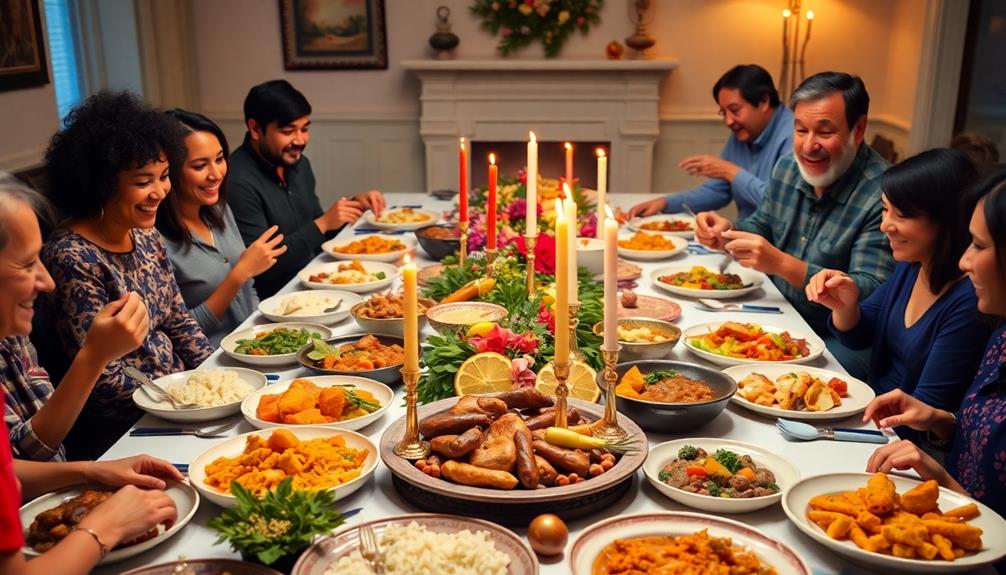
When you gather around the table for a holiday meal, something magical happens.
Sharing food with family and friends not only fills your belly but also creates lasting memories that warm your heart.
These special moments help build strong connections, reminding us all of the joy and togetherness that comes from enjoying a meal together.
Community Building Through Food
At the heart of holiday celebrations lies the transformative power of shared meals, which brings people together in ways that extend beyond the dining table. When you gather with loved ones, you're not just sharing food; you're building a community.
Here's how community building through food creates connections:
- Encourages Communication: As you share a meal, conversations flow freely, fostering deeper connections among family and friends.
- Symbolizes Unity: Preparing and enjoying food together shows that you care, creating warmth and togetherness that surpasses differences.
- Strengthens Traditions: Family recipes and communal dishes weave your stories into the fabric of your gatherings, passing down memories and traditions through generations.
- Promotes Trust: Breaking bread together encourages vulnerability, leading to meaningful conversations that strengthen your relationships.
These shared meals transform ordinary ingredients into extraordinary experiences, making them essential for emotional support.
So, the next time you sit down with your loved ones, remember that each bite is a step toward building a stronger community, filled with love and laughter.
Embrace the joy and connection that comes from sharing food, and let it bring you closer together!
Creating Lasting Memories
While shared meals during the holidays often feature familiar dishes, they also create lasting memories that linger long after the last bite. When you gather around the table with loved ones, the food transforms into something special. The flavors become sweeter because of the laughter and stories you share, turning ordinary moments into extraordinary experiences.
| Shared Meal | Memory Created |
|---|---|
| Grandma's lasagna | Family recipe traditions |
| Auntie's cookies | Baking together excitement |
| Dad's grilled steak | Summer barbecues nostalgia |
These shared meals foster a sense of connection, reminding you of the joy of togetherness. Each dish carries its own story, creating bonds that last a lifetime. As you pass down family recipes, you not only preserve culinary heritage but also strengthen community ties.
Frequently Asked Questions
Why Do We Eat Certain Foods on Holidays?
You eat certain foods on holidays due to tradition, nostalgia, and cultural significance. These meals often create lasting memories, strengthen bonds with loved ones, and enhance the joy of celebrating together, making the occasion feel special.
What Are Some Foods Associated With the Holiday?
Imagine sitting down to a feast. You'll likely find roast turkey at Thanksgiving, ham for Christmas, and latkes during Hanukkah. Each dish brings warmth and connection, making your holiday celebrations even more special and memorable.
Why Are Certain Foods Associated With Thanksgiving?
Certain foods are associated with Thanksgiving because they reflect historical traditions and available ingredients. You'll find turkey, pumpkin pie, and cranberries on the table, each representing cultural significance and the harvest season's bounty.
What Is One Food Strongly Associated With an American Holiday?
One food you'll likely think of during Thanksgiving is roast turkey. It's become a beloved tradition, symbolizing gratitude and abundance, and you'll find it gracing nearly every American table during this special holiday.
Conclusion
In the end, holiday foods bring us together in special ways! Did you know that 70% of families celebrate with a big meal? That's a lot of love shared over delicious dishes! These meals help us create happy memories and strengthen our bonds. So, whether it's a festive feast or a simple snack, let's cherish those moments. After all, it's not just about the food; it's about the laughter, stories, and joy we share with each other!


